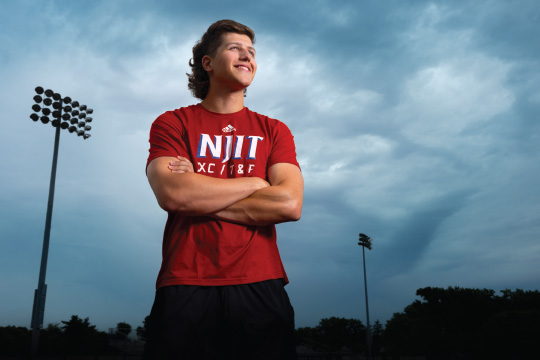A new procedure offers a less invasive alternative to traditional ACL surgery.

A rising star at the javelin throw, Thomas Kelly was warming up for a competition in the spring of 2022 when something went very wrong. Just as the New Jersey Institute of Technology (NJIT) sophomore planted his left foot, pain shot through his knee. “I felt as though the top of my kneecap had shifted position,” Kelly recalls. “The pain was just excruciating, and I fell.” After a few minutes, Kelly was able to stand up and walk on the injured leg, so he assumed he’d probably just dislocated his knee.
An MRI and a consultation with NJIT’s team physician Louis Rizio, MD, an orthopedic surgeon at Cooperman Barnabas Medical Center (CBMC), proved Kelly wrong. He had, in fact, torn his anterior cruciate ligament (ACL), a strong band of tissue that helps connect the thigh bone and the shin. Kelly was shocked and dismayed at the diagnosis. “I’d never heard anything good come out of any ACL tear,” he says. “I only heard ‘career-ending injury.’”
His worries were assuaged when Dr. Rizio told him he was a good candidate for a new surgical technique known as a BEAR (Bridge-Enhanced ACL Repair) implant. Unlike traditional ACL surgery, which involves reconstructing the ACL using a graft (a piece of ligament taken from another part of the patient’s body or from a cadaver), the BEAR technique entails attaching a collagen-based implant, infused with the patient’s own blood, to the torn ACL. The implant acts as a bridge between the two ends of the tear, providing scaffolding for new growth, while the infusion of blood helps the ligament heal. “The BEAR implant is a fantastic option for young patients,” says Dr. Rizio. “It has a much lower risk of injury to growing bones, and it’s much less invasive and destructive.”
Kelly’s surgery was a success. He’s currently undergoing rehab, which typically lasts six to nine months, though patients are usually back on their feet, with the help of a brace, almost immediately. “I do the procedure on high school kids,” says Dr. Rizio, “and after surgery on a Friday, they go back to school on Monday.” The recovery period is similar to that for ACL reconstruction, though physical therapy during the first four weeks may proceed a bit more slowly.
Kelly hopes that he’ll be back on track toward his goal of qualifying for the NCAA Division 1 regionals next March, and Dr. Rizio says there’s every reason to believe that he can achieve that goal. “With the BEAR implant,” he says, “the aim is to allow the patient to be as active as he wants to be, in any activity.”
View NBC video with Kelly and Dr. Rizio about Kelly's successful BEAR surgery.
Learn more about orthopedics at Cooperman Barnabas Medical Center.